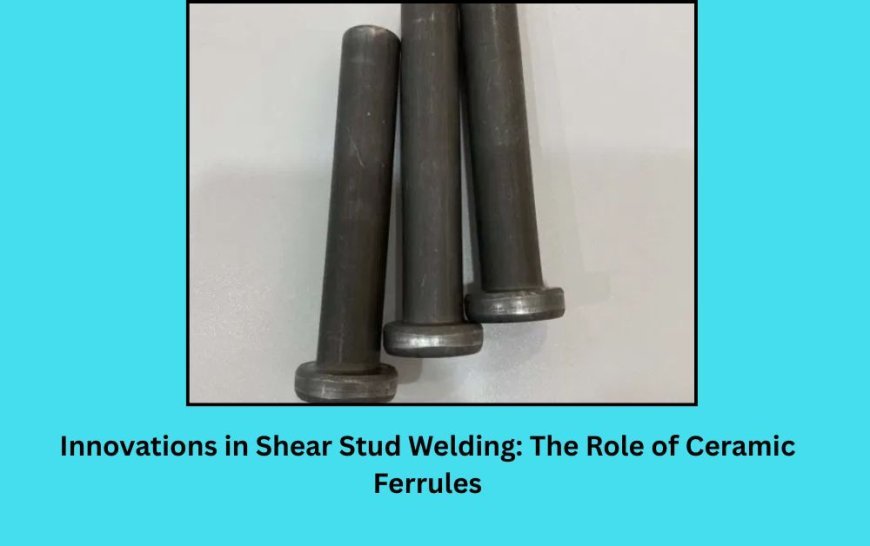Innovations in Shear Stud Welding: The Role of Ceramic Ferrules

Introduction
In modern construction and structural engineering, shear stud welding has emerged as a critical technique for connecting steel components and reinforced concrete. Its effectiveness lies in providing a reliable and efficient load transfer, particularly in composite structures such as steel-concrete floors and bridges.
Advancements in materials and welding technology have significantly improved the performance and durability of these connections. Among these innovations, the use of ceramic ferrules has gained prominence. This article explores the role of ceramic ferrules in shear stud welding, highlighting their benefits, applications, and best practices for achieving optimal results.
Understanding Shear Stud Welding
Shear stud welding is a process used to attach steel studs onto a base plate or a structural steel member. These studs help create composite action between steel and concrete, enhancing the load-bearing capacity of the structure.
How the Process Works
-
Stud Placement: Steel studs are positioned on the structural steel surface where welding is required.
-
Arc Welding: An electric arc melts the top of the stud and a small portion of the base material.
-
Cooling and Fusion: As the molten metal solidifies, a strong metallurgical bond forms, ensuring a secure connection.
The integrity of these welds directly affects the structural performance, which is why using the right techniques and materials is critical.

The Introduction of Ceramic Ferrules
Ceramic ferrules are insulating sleeves made from high-strength, heat-resistant ceramics. They are designed to encase the base of the stud during the welding process, helping to concentrate heat and control the molten pool.
Using a shear stud with ceramic ferrule improves weld quality and ensures consistent results, even in challenging conditions.
Why Ceramic Ferrules Are Important
-
Heat Concentration: The ferrule focuses the welding heat at the base of the stud, creating a stronger and more uniform bond.
-
Molten Metal Containment: By containing the molten pool, ferrules reduce the risk of weld collapse or splatter.
-
Enhanced Alignment: Ferrules help maintain the vertical alignment of studs during welding, improving installation accuracy.
-
Surface Protection: They prevent damage to surrounding areas, protecting the base steel and maintaining structural aesthetics.
Advantages of Using Shear Studs with Ceramic Ferrules
The adoption of ceramic ferrules in shear stud welding brings numerous benefits to construction projects.
Improved Weld Strength
The primary advantage of using a shear stud with ceramic ferrule is increased weld strength. By controlling the heat and shaping the molten metal, ferrules create more consistent and reliable bonds, reducing the risk of weld failure under load.
Reduced Defects and Rework
Weld defects such as misalignment, incomplete fusion, or cracking are common in traditional shear stud welding. Ceramic ferrules minimize these issues, leading to fewer reworks and faster project completion.
Enhanced Durability and Longevity
With stronger, more precise welds, structures exhibit greater durability. This is particularly important in heavy-duty applications such as bridges, high-rise buildings, and industrial facilities.
Cost Efficiency
While ferrules add a small upfront cost, the reduction in rework, improved quality, and faster installation make the overall process more cost-effective in the long run.
Applications Across Industries
Ceramic ferrules are used in a wide range of industries where shear stud welding is essential.
Construction Sector
High-rise buildings and commercial complexes frequently use shear studs with ceramic ferrules to ensure strong composite connections between steel beams and concrete floors.
Bridge Construction
In bridge decks and overpasses, ferrules help achieve consistent weld quality, even under challenging environmental conditions.
Industrial Facilities
Factories, warehouses, and heavy machinery platforms rely on shear studs with ferrules for durable, load-bearing connections that can withstand vibrations and dynamic loads.
NOTE : Enhance structural integrity with premium shear stud with ceramic ferrule from Oman Ocean Trading LLC. Our high-quality studs ensure reliable load transfer, superior weld strength, and long-lasting performance. Contact us today to secure the best fastening solutions for construction, industrial, and marine projects.
Best Practices for Shear Stud Welding with Ceramic Ferrules
To maximize the benefits of ceramic ferrules, following established best practices is crucial.
Material Selection
Choose high-quality studs and ferrules designed for the specific load and environmental conditions. Ensure that ferrules are resistant to thermal shock and wear.
Proper Positioning
Place the stud carefully within the ferrule to ensure vertical alignment and correct depth. Misalignment can lead to weld defects and reduced structural performance.
Controlled Welding Parameters
Maintain consistent arc time, voltage, and current to produce uniform welds. The ferrule helps manage heat, but operator control is still essential.
Post-Weld Inspection
After welding, inspect each stud for proper fusion, alignment, and bonding. Using non-destructive testing methods can verify weld integrity and prevent potential issues.
Common Challenges and Solutions
Despite their advantages, using ceramic ferrules may present some challenges.
Challenge: Ferrule Cracking
High welding temperatures can sometimes cause ferrule cracking. Using high-quality, heat-resistant ceramics reduces this risk.
Challenge: Reuse Limitations
Ceramic ferrules are often single-use due to deformation during welding. Planning for sufficient ferrule supply ensures uninterrupted workflow.
Challenge: Operator Training
Welding with ferrules requires proper training to achieve consistent results. Investing in skilled labor pays off in reduced defects and higher quality.
Innovations and Future Trends
The construction and welding industries continue to innovate in materials and processes. Recent developments include:
-
Advanced Ceramic Composites: Stronger, lighter ferrules that improve heat management and durability.
-
Automation: Robotic shear stud welding using ferrules ensures consistent quality and reduces human error.
-
Sustainable Materials: Research into recyclable and eco-friendly ferrules is underway, reducing environmental impact.
These innovations promise greater efficiency, reduced costs, and enhanced safety in large-scale construction projects.
Conclusion
The integration of ceramic ferrules in shear stud welding has revolutionized structural engineering by improving weld quality, reducing defects, and enhancing overall durability. Using a shear stud with ceramic ferrule ensures consistent results, reliable load transfer, and long-term performance in demanding environments.
From high-rise buildings to industrial facilities and bridges, adopting this technology simplifies the assembly process, minimizes maintenance, and delivers cost-efficient solutions. By understanding the role of ceramic ferrules and following best practices, engineers and construction professionals can maximize the benefits of shear stud welding and achieve safer, more resilient structures.
What's Your Reaction?


























































